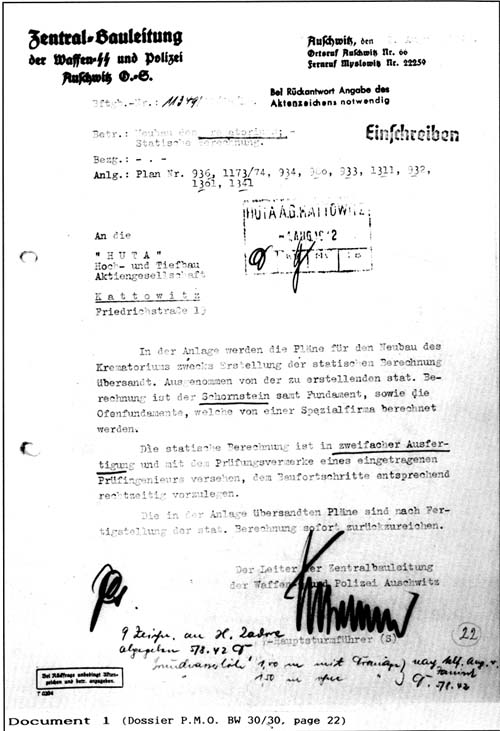 |
Document 1
[PMO file BW 30/30, page 22] |
|
| Translation: |
| Auschwitz, 2nd August 1942 |
Auschwitz Waffen SS and Police
Central Construction Management
Correspondence register no. 11349/42/Ja/Lp Quote ref in any reply |
| Register |
Subject: Construction of the Krematorium
Static calculations
Reference: —
Enclosure: Drawings 936, 1173/74, 934, 980, 933, 1311, 932, 1301, 1341 |
Messrs “HUTA”
Hoch and Tiefbau
Aktiengesellschaft
Kattowitz
19 Friedrichstraße
The enclosed drawings are sent for the purpose of producing the static calculations. Not to be included in these stat. calculations are the chimney and its foundation, and the furnace foundations, which are to be calculated by a specialist firm.
The static calculations are to be furnished in good time with respect to the progress of the work, in two copies and stamped by an authorized test engineer.
The enclosed drawings are to be returned as soon as the static calculations have been completed. |
Head of the Auschwitz Waffen SS
and Police Central Construction Management
[signed Bischoff] |
[Initials of the Huta site
superintendent at Auschwitz
Stephan (?)]
[Manuscript]
9 drawings given to Herr Zadore on 5/8/42 [initial]
Depth of water table: 1.00 m with drainage) According to information given
“1.50 m without” ) by phone by Janisch
[initial] 5/8/42 |
|
| Document 1 gives the numbers of the nine (1173/74 counts as a single drawing) Bauleitung drawings of the “Projected Krematorium” given to Herr Zadore (one of the Huta foremen working at Auschwitz), and which were supposed to be returned to the Bauleitung once the static calculations had been completed. In fact, Huta received four more drawings of the future Krematorium II — 935, 937, 1300 and 1541 — and the complete set of drawings was not returned to the Bauleitung until the end of July 1943 [Document 1 bis]. Thus the initial drawings of the two main Birkenau Krematorien, II and III, spent ALMOST A YEAR “floating around” in a civilian form whose employees were subject to no oath of secrecy of any sort and were free to talk outside. |
|

